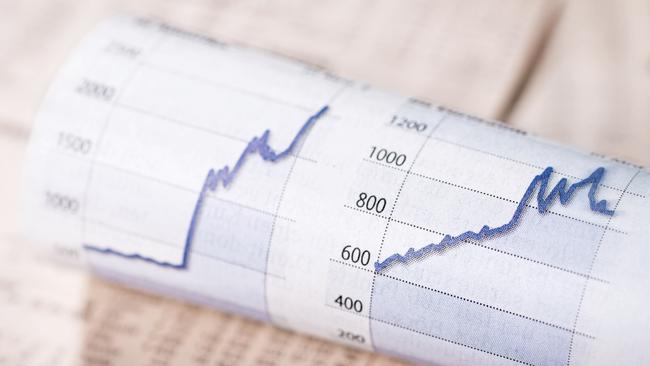Household wealth rising on equity bets too, not just housing boom
Younger Australians are piling into equities as they look to build wealth outside of the housing market.

Business
Don't miss out on the headlines from Business. Followed categories will be added to My News.
It might not feel like it, but Australian households are wealthier than ever – and not just because of surging property prices.
More and more wealth is being built through the sharemarket, in part as a generation finds itself locked out of the housing market.
And once again, a divide between old and young has emerged.
Households’ direct ownership of equities jumped by $51.8bn, or 3.8 per cent, in the December quarter, to $1.4 trillion. That’s a record high, according to the Australian Bureau of Statistics, and the fastest pace of growth since late 2020, when the market was in recovery mode following the Covid meltdown.
The near-4 per cent growth in the last three months of 2023 was on par with the 3.9 per cent rise in superannuation assets and almost double the 2 per cent growth in house prices, according to the ABS.
Property is still by far the biggest source of household wealth, at $10.7 trillion.
A nation of investors
We are a nation of investors. More than 10 million of us — that’s half of the adult population — hold investments outside of the primary residence and superannuation.
But Gen Z and Millennials are doing things differently. For a start, they’re shaking off the well-worn home bias favoured by their parents and searching further afield for growth.
The concentrated Australian sharemarket doesn’t hold the same appeal as it once did.
Sydney-based financial adviser Glen Hare, of Fox and Hare Wealth, says his clients – these are mostly Millennials and Gen Z – will often have their portfolios weighted toward US shares.
“Certainly the investments that we manage for our members have a very strong skew towards the US market,” Hare tells The Weekend Australian.
“Just because we’re based in Australia doesn’t mean we should be only investing in Australia. And having exposure to the largest economy in the world makes sense.”
At a high level, taking a young investor with a long-term outlook in a high growth strategy, the skew to the US would be close to 60 per cent, he says. Then 10 per cent in defensives like cash, and the remaining 30 per cent in Australia.
This is a trend that has been growing post-Covid.
New data from online trading app Pearler, whose average user is around 35 years old and invests in the market mostly through exchange traded funds, shows exposure to US sharemarkets has surged 138 per cent over the past two years to now make up 50 per cent of total holdings.
At the same time, Australian exposure on the platform has dropped from 44 per cent to 35 per cent, with global equities making up the rest.
Global equity exposure dropped from 35 per cent to 16 per cent in the two years to March.
This trend of young investors pushing outward to build wealth in the US market will likely gather pace, Pearler co-founder Nick Nicolaides says.
He sees US holdings accounting for 70 per cent of the platform’s total exposures in the near term.
“We’re already at 50 per cent, and so with a combination of our investors putting more money in the US alongside the rise of that market, it doesn’t take long to get to 70 per cent,” Nicolaides says.

“Investors these days are not tied to the same 20 or 30 stocks on the ASX. And for younger Australians, their wealth in 20 or 30 years is going to be driven far more by capital growth than dividends, so net net it’s a positive thing that this generation is getting exposure to international markets,” he adds.
The timing is certainly helped by recent performances.
The S&P 500 is up 27 per cent over the past year, the Dow Jones has risen 17 per cent and the Nasdaq has jumped 34 per cent, boosted by the likes of Nvidia, which has surged 224 per cent over 12 months. This compares with an 8 per cent rise on the S&P/ASX200.
Investing for financial freedom
But more than that, younger investors have very different motivations from the hobbyist of the past. Gen Z and Millennials are seeking financial freedom at a time when job and housing security are at all-time lows.
The sharemarket is seen, by some at least, as perhaps the only ticket out, save for the bank of mum and dad.
While older Australians are ploughing money into savings accounts to take advantage of higher rates — near $200bn has been added to households’ bank accounts since the cash rate started to push higher in May 2022 — younger investors are trying to find financial independence so they can work less, retire earlier or even just get enough money together for a house deposit.
“They understand that if they’re going to eventually get into property, if that’s what they want, then being an investor in shares is part of the ladder. It just has to be these days, when it’s taking 10 years or more to build a deposit,” Nicolaides says.
“It’s no longer enough to have a good job and save money. You need to be not only furthering your career by changing jobs every three to four years. You need to be saving, you need to be investing.”
It’s high risk, but this is a group that believes it can ride out the downturns. Up to 95 per cent of Pearler users say they’re holding onto positions for at least five years, while 80 per cent expect to hold for 15 years or more.
More Coverage
Originally published as Household wealth rising on equity bets too, not just housing boom





